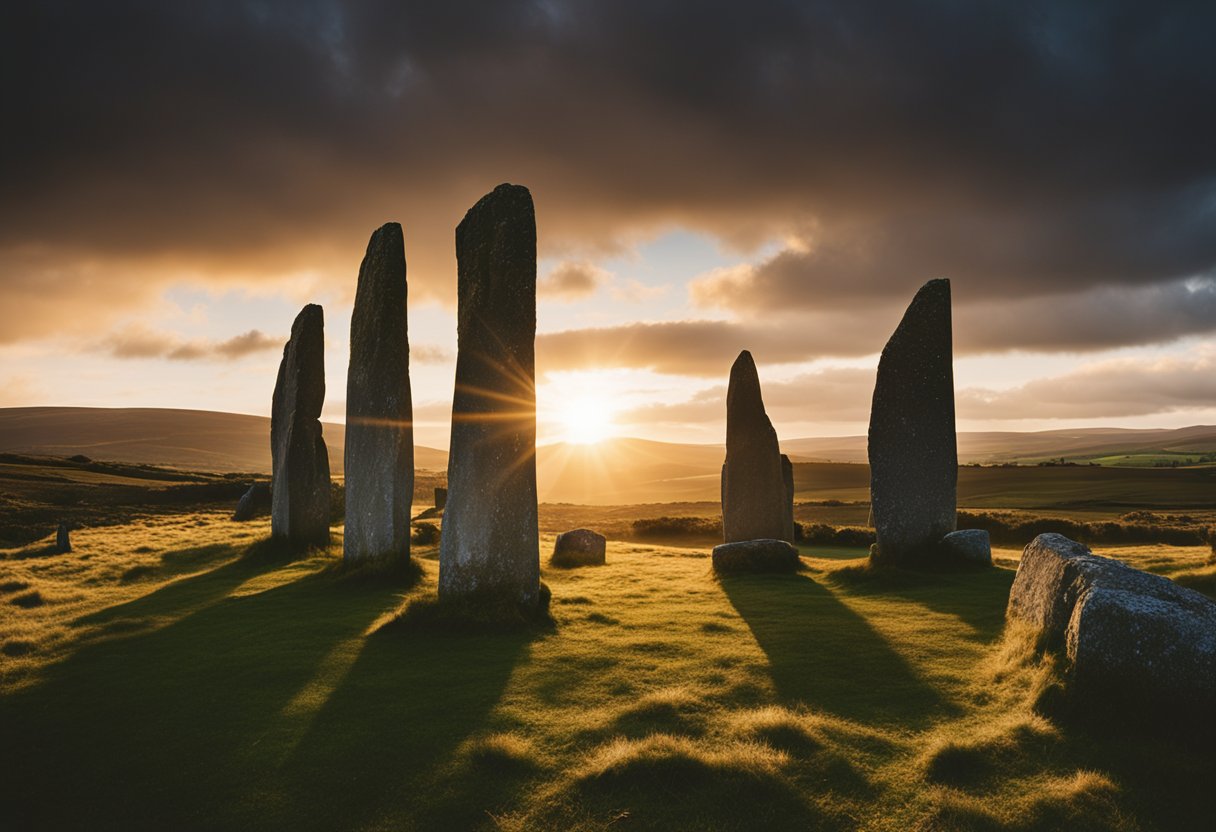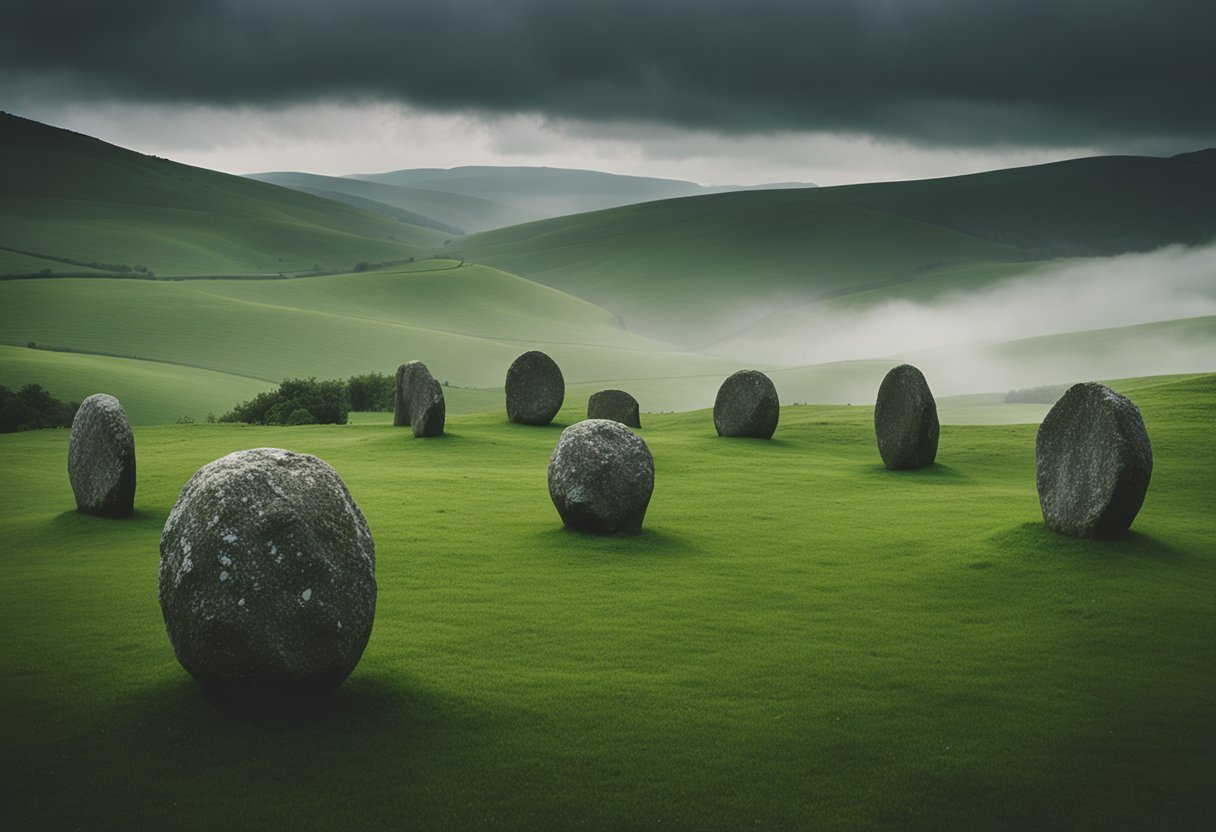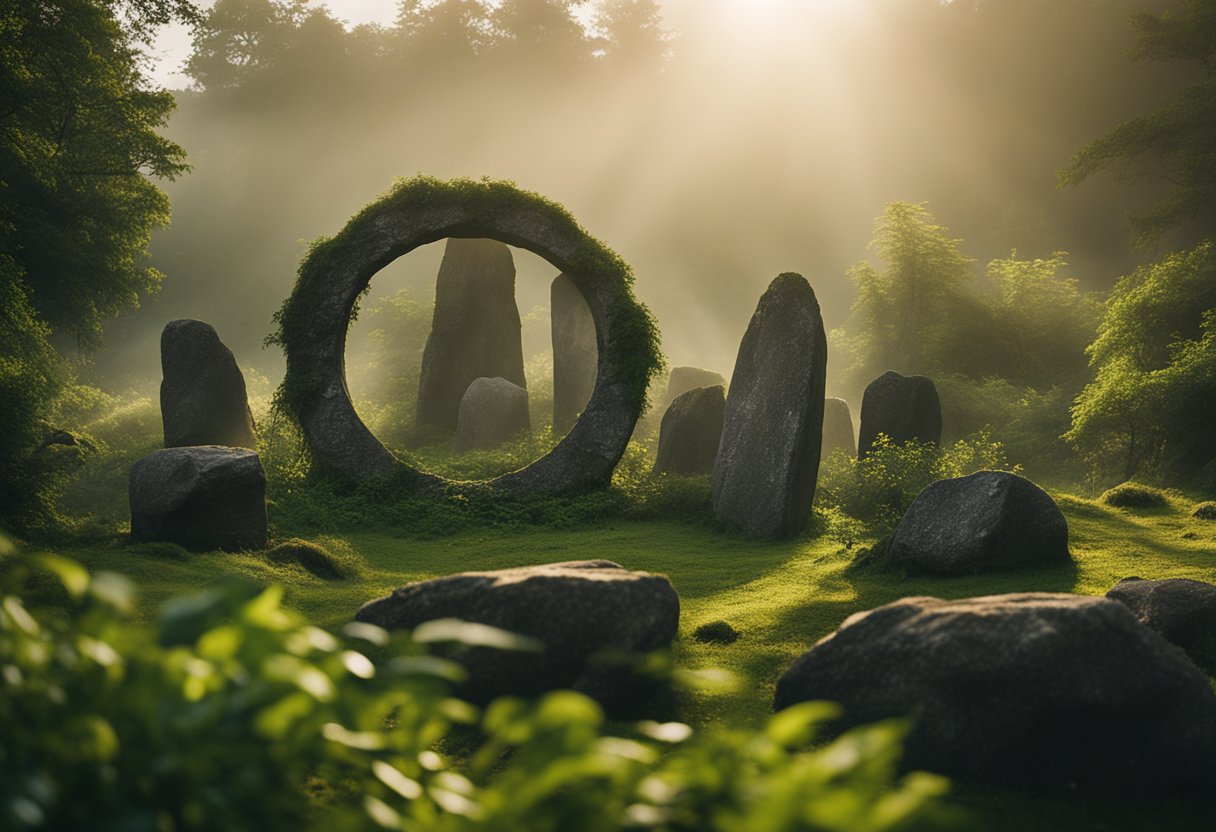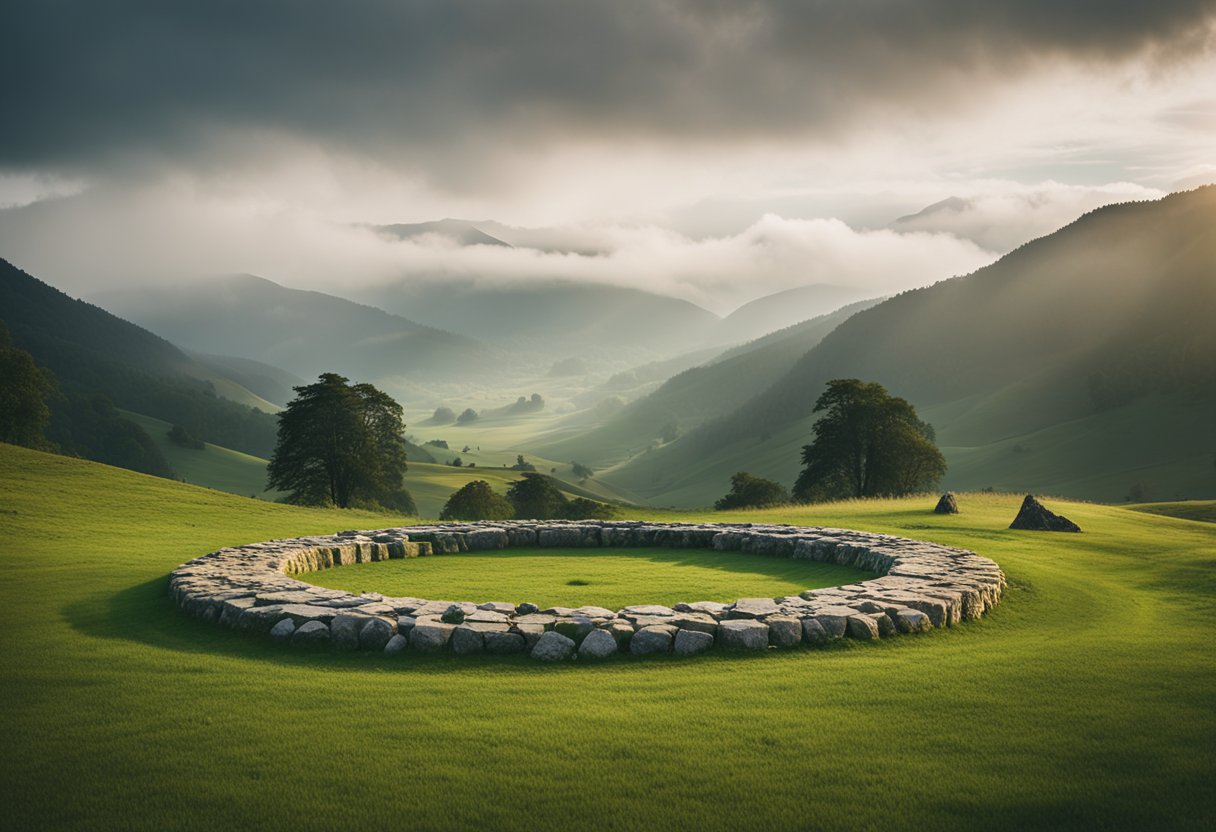Sacred Stones: Unveiling Ireland’s Ancient Monuments and Their Mystical Charm

Updated On: April 24, 2024 by Eman Sameh
Ireland’s landscape is a tapestry woven with the threads of mythical lore and historical reverence deeply rooted in its ancient monuments. These sacred stones and mystical sites stretch across the verdant hills and rugged coastlines, whispering stories of a bygone era. They serve as silent custodians of Ireland’s spiritual legacy, echoing the beliefs and rituals of the Celtic ancestors. From the enigmatic stone circles to the grand passage tombs, these monuments are a testament to Ireland’s rich and intricate past, inviting us to enter a world where myth intertwines with historical fact.

These ancient sites’ allure is found in their historical significance and the cultural and astronomical wisdom they embody. The precise placement of stones that mark celestial events and the rich folklore that enshrouds them reflect a deep understanding of the cosmos and its impact on life. This astronomical significance, coupled with the sites’ cultural influence, has perpetuated their mystique throughout the centuries. For us, they remain as a bridge between the present and the ancient past, revealing insights into the lives and beliefs of those who came before us.
We recognise the importance of protecting these irreplaceable testaments of Ireland’s heritage. In our modern world, they take on new meanings and continue to influence our interpretation of history and spirituality. They compel us to consider how we might preserve their legacy for future generations while respecting their enigmatic origins.
The Spiritual Legacy of Ireland
As we explore the ancient landscape of Ireland, we’re immediately drawn to its profound spiritual heritage, marked by mystic sites and enduring legends that have captivated people for centuries.
Sacred Sites and Their Significance
Throughout Ireland, the land is dotted with various sacred sites, each bearing a rich tapestry of spiritual importance. These sites, ranging from stone circles to majestic burial grounds, serve as a portal into a bygone era when rituals and ceremonies underpinned the very fabric of society. The Drombeg Stone Circle, also known as “the Druid’s Altar,” remains an evocative reminder of Ireland’s pagan past, where ceremonies likely aligned with the solar and lunar cycles took place.
The presence of Neolithic art at Knowth, which represents a quarter of all such art found in Europe, offers a unique window into Ireland’s ancient soul. These monuments are not only archaeological treasures but also hold a deep spiritual significance. They are believed to be sacred sites where the veil between worlds was once considered thin.
Mysticism and Myths
Embedded within the Irish landscape is a bedrock of mysticism and myths, where every stone and hill is threaded with tales of magic and spirits. The Giant’s Causeway is a geological marvel shrouded in tales of giants from the ancient Celtic imagination, revealing how storytelling and the natural world intertwine.
These myths bind together Ireland’s identity, underscoring its ancient monuments as more than remnants of history. They become narratives that convey beliefs, values, and the enthralling idea that Ireland’s natural landscape is a canvas for the mystical allure that has defined this nation for millennia.
The Ancient Monuments of Ireland
Ireland’s landscape is a palimpsest of history, with ancient monuments dotted across its verdant terrain. These enduring structures are a testament to the island’s mysterious past, offering us a window into the lives of our Neolithic ancestors.
Neolithic Tombs
Neolithic Ireland was marked by constructing passage tombs and monumental structures such as Newgrange, Knowth, and Dowth. These burial mounds, found within the Brú na Bóinne complex, are remarkable feats of prehistoric engineering, aligning with celestial events such as the winter solstice sun. Similarly, the Loughcrew cairns and the Mound of the Hostages on the Hill of Tara reveal intricate stone carvings and astronomical alignments.
Stone Circles
Our ancestors also left behind enigmatic stone circles, with notable examples including the Drombeg Stone Circle in County Cork and the Beltany Stone Circle in County Donegal. The circle at Drombeg, locally known as “the Druid’s Altar,” comprises 17 standing stones and is one of the most visited megalithic sites in Ireland. Additionally, the Ballynoe Stone Circle and the Athgreany Stone Circle are among the hundreds scattered across Ireland, each with its own unique configuration and lore.
Standing Stones
Standing stones punctuate the Irish countryside, ranging from singular, enigmatic monoliths to elaborate alignments. The Lia Fáil, or ‘Stone of Destiny,’ crowns the Hill of Tara, a site rich with political and spiritual significance. These standing stones found alone or in groups, often mark ancient sites or serve as territorial boundaries and are associated with various myths and cultural practices.
Through these monuments, we are connected to Ireland’s distant past, from the majestic passage tombs to the ritualistic stone circles and solitary standing stones. Each stone and mound tells a part of our shared story, grounding us in a heritage that stretches back over 5,000 years.
Historical Context and Archaeology
Ireland’s ancient monuments are windows into a past that stretches back to the Neolithic period, offering insights into the lives and beliefs of its early inhabitants. These sacred stones, from passage tombs to monolithic structures, are the focus of intense archaeological study, cumulatively revealing a tale of preservation, significance, and continuity through radiocarbon dating and meticulous research.
Excavation and Preservation of Sites
Our understanding of these monuments is largely thanks to dedicated excavations, which proceed with a deep respect for both the artefacts and the landscape. Preserved sites, regarded as national monuments, provide invaluable information about societal structures and spiritual practices from the Neolithic period through the Bronze and Iron Ages to the introduction of Christianity. Teams work to ensure the sites are left intact, allowing us to gain knowledge while leaving the monuments available for future generations.
Notable Efforts
- Passage tombs: Excavations have revealed these tombs were not only burial grounds but also centres of ceremonial practices.
- Bronze Age structures: Findings include artefacts and remnants of settlements that offer a glimpse into life and death during this era.
Radiocarbon Dating and Research
Radiocarbon dating is a pivotal tool that allows us to place artefacts within a specific timeframe, illuminating the chronology of Ireland’s human activity. Through careful analysis, we ascertain the age of objects found within or around sacred stones, providing context and narrative to these sites. Our research extends to the impact of these findings on our current understanding of ancient Irish cultures and their development through time.
Key Discoveries
- Neolithic artefacts: Linked to specific time periods, helping to trace the evolution of communal practices.
- Iron Age relics: Dated to establish the continuity and changes leading to and following the arrival of Christianity.
Astronomical Significance

Our ancient monuments are not just cultural treasures; they are also windows into our ancestors’ astronomical knowledge. The alignments and art within these structures reveal a sophisticated understanding of celestial events.
Solar Events and Alignments
Many of Ireland’s ancient monuments are aligned with key solar events, especially the winter solstice. The most renowned example is Newgrange, a megalithic passage tomb where the inner chamber dramatically illuminates only on the morning of the solstice. The purposeful orientation of such sites indicates a deep significance placed on the sun’s cycle by those who constructed them.
Lunar Cycles and Observations
Beyond solar observations, Ireland’s ancestors may also have monitored the lunar cycles. Artefacts and Neolithic art found at sites like Knowth suggest a possible link between these carvings and the moon’s phases or eclipses. Such lunar observatories highlight the advanced astronomical alignment knowledge possessed by the megalith builders.
Cultural Influence and Folklore
Ireland’s ancient monuments are not only testaments to architectural ingenuity but also vivid storytellers of the island’s enduring myths and folklore. The mystical allure embedded within these stones speaks to the Celtic traditions and the supernatural beings believed to roam the verdant landscapes.
Celtic Mythology
The Celts, with their rich pantheon of gods, heroes, and otherworldly creatures, left behind a powerful cultural legacy that continues to infuse Ireland’s historical sites with wonder. The Tuatha Dé Danann, a people of god-like abilities, are central to countless Irish myths, including those surrounding the mystic Hawthorn tree, thought to guard the entrance to their ethereal realms. Sites like the Seat of the High Kings of Ireland resonate with the sagas of mighty rulers, such as the celebrated King of Tara, and the storied battles that shaped the early Irish consciousness.
Fairy Lore and Other Tales
Beyond the epic tales of gods and warriors, the Irish landscape brims with stories of fairies and other supernatural entities. The hawthorn tree, often standing alone in a field, is revered and feared, for it is said to be a favourite dwelling of the fairies, and to harm it would invite their wrath. Legends of the spirited piper who defies time and the cunning witch who bends it to her will enrich the tapestry of Irish lore. Queen Maeve herself, a figure of magic and power, is immortalised in the tales of Connacht and her reputed burial mound at Knocknarea, woven into the nation’s cultural fabric.
Monumental Sites to Visit
In this section, we delve into some of Ireland’s most storied ancient monuments, each with its own unique narrative and mystical charm.
Brú na Bóinne
Considered one of Ireland’s most significant prehistoric landscapes, Brú na Bóinne is a World Heritage Site in County Meath, renowned for its megalithic passage tombs of Newgrange, Knowth, and Dowth. Newgrange, approximately 5,200 years old, predates the Great Pyramid of Giza and Stonehenge. Newgrange is especially known for its winter solstice phenomenon, where sunlight penetrates the inner chamber as the sun rises.
Beara Peninsula
In County Kerry and County Cork, the Beara Peninsula offers more than breathtaking landscapes; it’s steeped in legends and scattered with ancient monuments. The rugged terrain houses stone circles, standing stones, and historic ruins. Of keen interest is the egg-shaped Kenmare Stone Circle, one of the largest in the southwest, thought to be linked to religious rituals dating back to the Neolithic period.
County Meath
County Meath holds the heart of Ireland’s ancient past within its bounds. Aside from Brú na Bóinne, you’ll find the lesser-known but equally enthralling Loughcrew Cairns, often referred to as Ireland’s forgotten passage tombs. These ancient sites dotted across the Loughcrew Hills offer a more serene visit away from the crowds, allowing one to ponder the mysteries of Neolithic Ireland in solitude.
The Role of Standing Stones
In our exploration of Ireland’s rich archaeological heritage, we find that standing stones play a multifaceted role in the ancient landscape. These monoliths are not only markers of spiritual significance but are also thought to have served as territorial boundaries or focal points for social gatherings.
Significance of Individual Stones
Standing stones, known colloquially as menhirs, often stand alone on the landscape, their solo presence suggesting a role far beyond the mere physical marker. Many such stones are linked with myths, such as the legendary Stone of Destiny at Hill of Tara, believed to roar when the rightful king of Ireland touched it. Individual stones can also denote burials or mark celestial events, such as Bealtaine, highlighting their astronomical importance.
Configurations and Settings
The placement of standing stones in stone circles exemplifies their communal relevance. These settings, like the large and complex site known as the Ballynoe Stone Circle, embody a cosmic link, with alignments potentially reflecting solstices and equinoxes. Configurations may include portal stones, creating an entrance, and an axial stone, which was possibly a focal point during rituals or gatherings.
Myth vs Historical Fact
In examining Ireland’s ancient monuments, we discern fact from fiction by exploring their origins and the influences that shaped them.
Sacred Stones Origins
The myths surrounding Ireland’s sacred stones often blur with historical fact. For instance, the Drombeg Stone Circle is steeped in legend, referred to as “the Druid’s Altar”, yet it is a real Neolithic site used for rituals and ceremonies. While myths attribute mystical powers to these sites, archaeological evidence points to their creation during the Neolithic and Bronze Age periods.
The Influence of Other Civilisations
Cultural exchanges have always been influential, as seen in the complex construction of Ireland’s ancient monuments, hinting at possible knowledge shared between civilisations. The grandiosity of structures like the Pyramids of Egypt, dating back to a similar era, indicates a wider web of civilisational contact that might include Ireland. Additionally, comparisons with Scottish megaliths suggest a shared tradition across regions during the Bronze Age, reinforcing the idea that these ancient societies were not isolated in their efforts but possibly interconnected.
Protecting Ireland’s Heritage

Our commitment to safeguarding Ireland’s ancient sites includes measures to ensure they are preserved for future generations. This includes conservation efforts to maintain the integrity of these monuments and securing UNESCO World Heritage Site status for global recognition and protection.
Conservation Efforts
We actively champion the conservation of Ireland’s national monuments, ensuring that these testaments to our ancestors are kept from harm. Significant structures like the megalithic tombs of Brú na Bóinne in the Ancient East and the monastic sites in Leinster have been carefully maintained. By meticulously preserving these sites, we honour the heritage handed down to us.
UNESCO and Global Recognition
Our cherished landmarks, once named UNESCO World Heritage Sites, garner global awareness and appreciation. The nomination process itself raises consciousness of the site’s universal value while increasing support for its preservation. Through this, privacy policies and guidelines are strictly followed to protect both the heritage and the rights of visitors alike.
Interpretation and the Modern World

Exploring Ireland’s ancient monuments reveals that their interpretation holds a significant place in the modern world, often intertwining with education and cultural identity and drawing in tourism.
Educational Resources
Irish sacred sites serve as important educational resources. Students and scholars from around the globe are drawn to these ancient stones, seeking to understand the lives and beliefs of our ancestors. Consider the Drombeg Stone Circle, often referred to as “the Druid’s Altar”, where every stone has a story, encapsulating a history that predates our written records. These sites are not just lessons in history but in fields as diverse as archaeology, anthropology, and mythology, offering a multidisciplinary approach to learning.
Cultural Identity and Tourism
Our cultural identity is closely linked to these mystical landmarks. For instance, the Giant’s Causeway is not only a geological wonder but also a part of our lore and ancient legends. In terms of tourism, these monuments are pivotal, attracting visitors to Ireland who seek to connect with the past. Responsible tourism, as advocated by platforms like Connolly Cove, ensures that these treasured sites are preserved for future generations. This balance between accessibility and conservation is essential to maintaining the privacy and sanctity of our sacred spaces.
By delving into the past and preserving it through education and conscientious tourism, we keep the spirit of these age-old stones alive. Our handling of these sites reflects our values and shapes the experience of every visitor who comes to witness Ireland’s enduring legacy.
Frequently Asked Questions
In this section, we answer some of the most common enquiries regarding the mystical allure of Ireland’s ancient stone monuments, artefacts of deep historical and cultural significance that continue to captivate scholars and visitors alike.
What is the significance of stone circles in Irish history?
Stone circles in Irish history are often connected to various rituals and ceremonies. They are believed to have been significant for religious and social gatherings in ancient times. These structures are a testament to Ireland’s rich Neolithic and Bronze Age heritage.
Which is the most renowned stone circle in Ireland?
The Drombeg Stone Circle in County Cork is one of the most famous and well-preserved stone circles in Ireland. It consists of seventeen closely spaced stones and is often referred to as ‘The Druid’s Altar’.
Could you elucidate the function of standing stones in ancient Ireland?
Standing stones in ancient Ireland serve as prehistoric markers, which may have been used for astronomical, ceremonial, or territorial purposes. They are commonly associated with ancient burial grounds and are often found in locations with panoramic vistas.
What are the beliefs associated with rocks and stones in Celtic culture?
In Celtic culture, rocks and stones were often imbued with sacred significance, representing a connection to the earth and the ancestors. Certain stones held particular mythological importance and were thought to possess healing powers or the ability to grant wishes.
Where can one find the most significant concentration of pagan sites in Ireland?
The most significant concentration of pagan sites can be found in the Boyne Valley, County Meath, which is home to ancient monuments such as the Newgrange passage tomb, a site older than Stonehenge and the Great Pyramids of Giza.
Is there a guide or map detailing the location of stone circles across Ireland?
There are resources available that detail the locations of stone circles across Ireland, such as the comprehensive guide on ConnollyCove. This site provides visitors with information on sites worth visiting for anyone keen on exploring these ancient monuments.






